Since our last project update on Addendum, we have been focusing on researching more into Eva Hesse’s practice, finalising the mock-ups and carrying out our extensive cleaning system evaluation and refinement process.
As discussed in the previous updates, it was evident that the ropes have a secondary transparent coating covering the PVAc layer which was identified as an unpigmented acrylic emulsion. We found a good match for the secondary coating using a conservation grade material and after Angelica carried out analysis, which confirmed we had a good match, it was applied to the mock-up ropes.
Once we applied all of the coatings, we soiled our mock-ups with artificial indoor soil. This is made up of a number of elements including, amongst many other ingredients, pigments and oils. Due to the texture of our Addendum mock-ups, the soil was applied using an air brush.
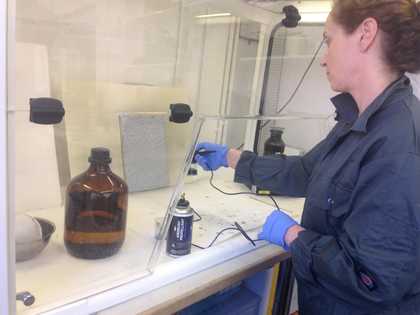
Tamar applying the artificial soil under a fume cupboard; as the samples were placed at the back of the fume hood no other personal protective equipment, such as safety masks, were needed. Our soiled samples were then returned to the ageing chamber to allow the artificial soil time to become at least partially embedded into the paint layer. This will make the soiling slightly more difficult to remove, and better replicate the surface of the sculpture.
After a few weeks in the chamber the mock-ups were ready for testing. During the ageing period, the NANORESTART team researched, discussed and decided on an approach to the cleaning tests and made a comprehensive list of the cleaning options to be evaluated. These included commonly used materials such as deionised, adjusted and buffered waters, chelating agents and surfactants, and a range of established gels as well as more novel systems, including the gels produced as part of the NANORESTART project.
Each cleaning system was tested, documented and recorded in a very systematic way. We began by testing the selected cleaning materials by applying them on both the papier mâché and rope mock-ups with a cotton swab. For each test, we visually evaluated the impact of the cleaning systems on the painted and coated surfaces, and recorded its efficacy in removing the dirt, and any unwanted and/or detrimental effects.
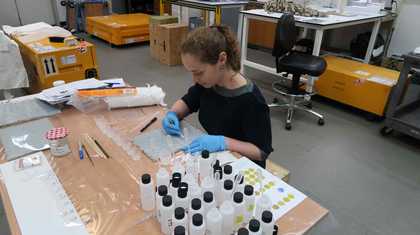
Testing sites of several cleaning solutions on the surface of a mock up board using cotton swabs

Mock-up rope number 2 with testing sites marked out on the Mylar template and test swabs saved for observation and/or possible analysis.
Once we identified the most promising cleaning solutions, we started to evaluate which was the most effective and safe way to apply them onto the sculpture. Alongside applications using cotton swabs and cosmetic sponges, we also started preparing different types of gels, such as agarose, polyvinyl alcohol-borax, xanthan gum, Shin-Etsu KSG 350z (silicone emulsifier) and the new polyvinyl alcohol/polyvinylpyrrolidone (PVA/PVP) and polyvinyl alcohol(PVA)-based gels synthesised by the NANORESTART lead partner CSGI (Research Centre for Colloid and Surface Science, University of Florence, Italy).
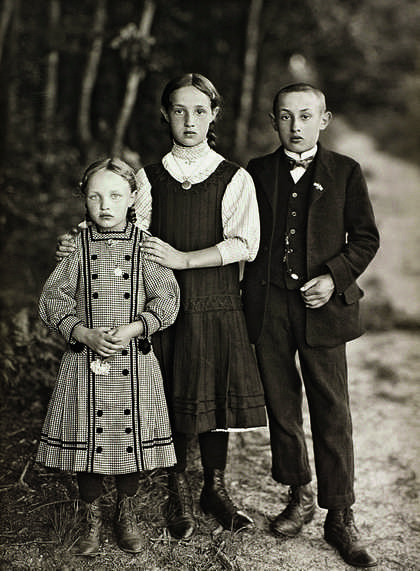
Testing one of gels synthesised by CSGI for the NANORESTART project on the surface of the rope mock ups.
Each gel, used alone and then combined with the best aqueous cleaning solutions, was applied to the mock-ups and immediately evaluated for a range of empirical observations such as soil removal efficacy, changes in gloss, ease of use, ease of preparation and health and safety.
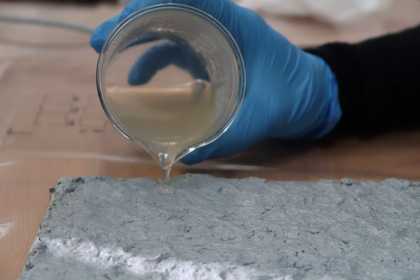
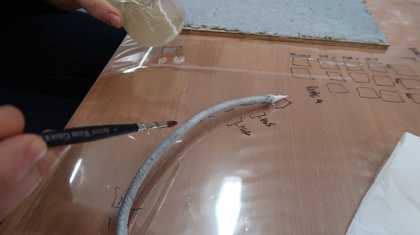

The sequence of images above shows the application of the agarose gel on the mock-ups. Due to the textured surface of the mock-ups, we decided to apply warm agarose gel by pouring it directly onto the surface of the papier mâché mock-up and by brushing it onto the ropes; the gel was then gently removed from the surface using a silicone spatula.
We then used imaging techniques (i.e., a HIROX digital microscope purchased by Tate within the NANORESTART project) to record any potential change to the mock-up surface before and after cleaning and to further assess how each cleaning method performed.
At this stage, we are seeing some favourable results from the extensive evaluations carried out on our mock-ups. In our next update, we will discuss taking the most promising combination of cleaning systems and application methods to the surface of the sculpture. From the results we have gathered so far, it seems likely that we will need different cleaning approaches for the papier mâché and the ropes, due to the fact that the surfaces, the soiling interaction and degree of soiling on each section of the sculpture are different.
Tamar Maor, Angelica Bartoletti, Bronwyn Ormsby
January 2018
